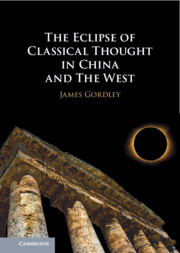Book contents
- The Eclipse of Classical Thought in China and the West
- The Eclipse of Classical Thought in China and the West
- Copyright page
- Dedication
- Contents
- Acknowledgments
- 1 The Dilemma
- Part I Two Ancient Traditions
- Part II The Formation of Two Constitutions
- Part III The Eclipse of Classical Thought
- 10 Neo-Confucianism
- 11 The Path to Orthodoxy
- 12 The Rise and Fall of Western Rationalism
- 13 The Search for Alternatives
- 14 Conclusion
- Appendix The Encounter with the Abrahamic Religions
- Index
11 - The Path to Orthodoxy
from Part III - The Eclipse of Classical Thought
Published online by Cambridge University Press: 26 July 2022
- The Eclipse of Classical Thought in China and the West
- The Eclipse of Classical Thought in China and the West
- Copyright page
- Dedication
- Contents
- Acknowledgments
- 1 The Dilemma
- Part I Two Ancient Traditions
- Part II The Formation of Two Constitutions
- Part III The Eclipse of Classical Thought
- 10 Neo-Confucianism
- 11 The Path to Orthodoxy
- 12 The Rise and Fall of Western Rationalism
- 13 The Search for Alternatives
- 14 Conclusion
- Appendix The Encounter with the Abrahamic Religions
- Index
Summary
The School of Principle was recognized as the correct interpretation of Confucianism from the late Song dynasty until the end of imperial China.
When it first appeared, the School was regarded as dangerous. The works of Cheng Yi were prohibited most of the time from 1103 to 1155. It is said that only four people were brave enough to go to his funeral. Zhu Xi was dismissed from office several times on account of his philosophical views. In 1196, his teachings were prohibited, and there was a call for his execution. One contemporary described his funeral as “a gathering of heretics from all over the empire to follow the arch-heretic to the grave.”
- Type
- Chapter
- Information
- The Eclipse of Classical Thought in China and The West , pp. 228 - 251Publisher: Cambridge University PressPrint publication year: 2022

